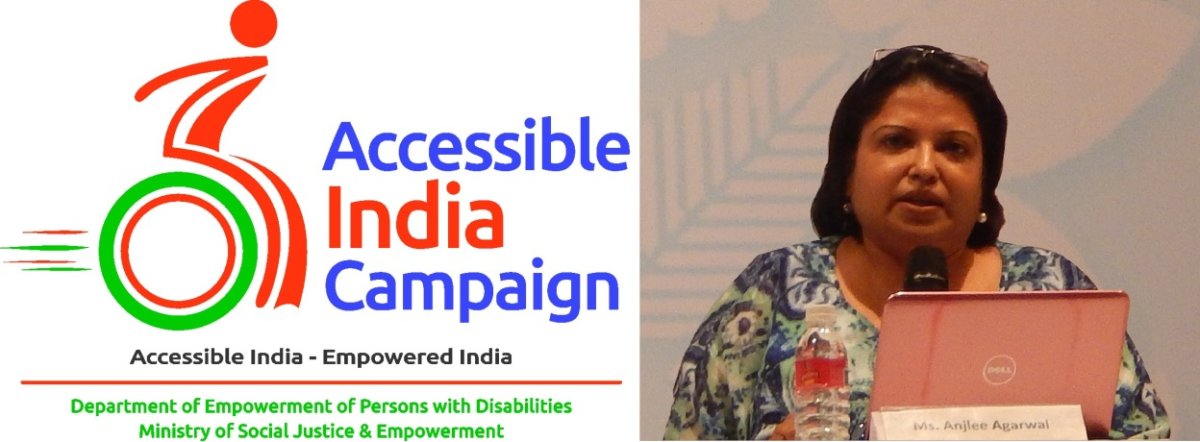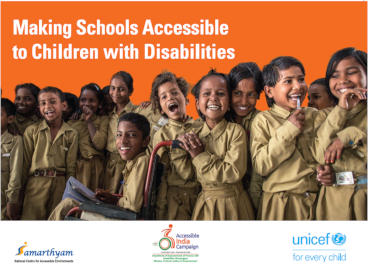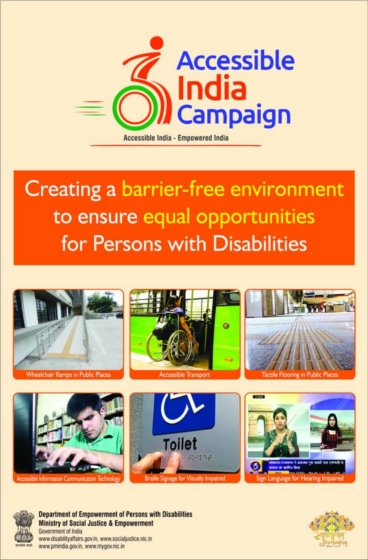Accessible India Campaign
Accessible India Campaign

Accessible India Campaign is a nationwide flagship campaign of Govt. of India (Department of Empowerment of Persons with Disabilities, Ministry of Social Justice & Empowerment) for achieving universal accessibility for all citizens including the elderly & persons with disabilities. The campaign focuses on Built Environment, Public Transportation and Information and Communication Technologies (ICT).
Samarthyam is empanelled Access Auditor with Government of India and is Member, Steering Committee of Accessible India Campaign to promote its objective & targets. Since 2015, we have also supported the government to develop the Strategy Paper of the campaign with indicators & timeline.
Samarthyam has conducted access audits in 23 cities of India covering 12360 buildings and transport terminuses under the campaign. Access audits in urban, semi-urban and rural areas are underway. Technical capacity building workshops for Central Public Works Department, State Public Works Department, engineers, architects and contractors, etc. are also being organized to ensure that there is in-house technical expertise to audit and assess the built environment.


Accessible India Campaign
Department of Empowerment of Persons with Disabilities (DEPwD) launched Accessible India Campaign (Sugamya Bharat Abhiyan) as a nation-wide Campaign for achieving universal accessibility for Persons with Disabilities (PwDs) on December 3,2015. It has three important verticals, namely - the Build Environment, the transportation sector and the ICT ecosystem.
Part A: Built Environment Accessibility
An accessible physical environment benefits everyone, not just persons with disabilities. Measures should be undertaken to eliminate obstacles and barriers to indoor and outdoor facilities including schools, medical facilities, and workplaces. Further these would include all public spaces such as roads, footpaths, parks and gardens etc.
Objective 1: Enhancing the proportion of accessible government buildings
An accessible government building is one, where persons with disabilities have no barrier in entering it and using all the facilities therein. This covers the built environment – services, steps and ramps, corridors, entry gates, emergency exits, parking – as well as indoor and outdoor facilities including lighting, signages, alarm systems and toilets. Identifying accessible buildings requires annual accessibility audits that determine if a building meets agreed upon standards. Once a building is deemed fully accessible, an annual audit is not necessary, but should be required for any proposed changes to the structure or systems contained therein. A full audit can then be done on a less frequent basis. Standards of accessibility should be as consistent as possible with international standards, such as those of the ISO, taking into account the local context. In regards to the built environment, ISO 21542:2011, Building Construction – Accessibility and Usability of the Built Environment, delineates a set of requirements and recommendations concerning construction, assembly, components and fittings.
- Target 1.1: Conducting accessibility audit of at least 25-50 most important government buildings and converting them into fully accessible buildings in the selected 50 cities by June 2022.
- Target 1.2 : Converting 50% of all the government buildings of National Capital and all the State capitals into fully accessible buildings by June 2022.
- Target 1.3: Conducting audit of 50% of government buildings and converting them into fully accessible buildings in 10 most important cities / towns of all the States (other than those, which are already covered in Target 1.1 and 1.2 above) by June 2022.
Part B: Transportation System Accessibility
Transportation is a vital component for independent living, and like others in society, PwDs rely on transportation facilities to move from one place to another. The term transportation covers a number of areas including air travel, buses, taxis, and trains.
Objective 2 : Enhancing proportion of accessible airports
An airport is accessible, if a person with a disability has no barrier in entering it, using all the facilities, and boarding and disembarking from airplanes. This covers the built environment – surfaces, steps and ramps, corridors, entry ways, emergency exits, parking – as well as indoor and outdoor facilities including lighting, signage, alarm systems and toilets.
- Target 2.1: Conducting accessibility audit of all the international airports and converting them into fully accessible international airports by June 2022.
- Target 2.2: Conducting accessibility audit of all the domestic airports and converting them into fully accessible airports by June 2022.
Objective 3 : Enhancing the proportion of accessible railway stations
- Target 3.1: Ensuring that A1,A & B categories of railway stations in the country are converted into fully accessible railway stations by June 2022.
- Target 3.2: Ensuring that 50% of railway stations in the country are converted into fully accessible railway stations by June 2022.
Objective 4 : Enhancing the proportion of accessible Public Transport
- Target 4.1: Ensuring that 25% of Government owned public transport carriers in the country are converted into fully accessible carriers by June 2022.
Part C: Information and Communication Eco-System Accessibility
Access to information creates opportunities for everyone in society.People use information in many forms to make decisions about their daily lives. This can range from actions such as being able to read price tags, to physically enter a hall, to participate in an event, to read a pamphlet with healthcare information, to understand a train timetable, or to view webpages. No longer should societal barriers of infrastructure, and inaccessible formats stand in the way of obtaining and utilizing information in daily life. The targets set under the relate to websites, the audio-visual media and sign language interpreter.
Objective 5 : Enhancing proportion of accessible and usable public documents and websites that meet internationally recognized accessibility standards
This target will ensure conversion of public documents published as of a specified year and all current websites meeting the relevant International Organization for Standardization (ISO) criteria, that are found in ISO / IEC 40500 : 2012, Information Technology – W3C Web Content Accessibility Guidelines (WCAG) 2.0. Public documents refer to all documents issued by the national government as well as all subnational documents. They include all publications such as laws, regulations, reports, forms and informational brochures.
- Target 5.1: Conducting accessibility audit of 50% of all government (both Central and State Governments) websites and converting them into fully accessible websites by June 2022.
- Target 5.2 : Ensuring that at least 50% of all public documents issued by the Central Government and the State Governments meet accessibility standards by June 2022.
Objective 6: Enhancing the pool of sign language interpreters
- Target 6.1 : Training and developing 200 additional sign language interpreters.
Objective 7: Enhancing the proportion of daily captioning and sign-language interpretation of public television news programmes
The proportion of public television news programmes that meet agreed upon standards of daily captioning and sign-language interpretation. Public television refers to programmes that are produced, funded or subsidized by the government.
- Target 7.1 Developing and adoption of national standards on captioning and sign-language interpretation in consultation with National media authorities by June 2022.
- Target 7.2 Ensuring that 25% of all public television programmes aired by government channels meet these standards by June 2022. Accessibility is about giving equal access to everyone. Without being able to access the facilities and services found in the communities, persons with disabilities will never be fully included. Accessible India Campaign will seek cooperation of all Central Government Departments/Ministries and State Governments to progress towards making India universally accessible.
Standards/Guidelines notified under the Rights for Persons with Disabilities Rules 2017
- Harmonised Guidelines and Space standards for Barrier Free Environment for Persons with Disabilities.
- Accessibility-standards-for-persons-with-disabilities-in Bus Body Code.
- Accessibility-standards-for-persons-with-disabilities-in Railway.
Sugamya Bharat App
Accessible India Campaign - Frequently Asked Questions (FAQs)
Q1.What is Accessible India Campaign?
Accessible India Campaign (Sugamya Bharat Abhiyan) as a nation-wide Campaign for achieving universal accessibility for Persons with Disabilities (PwDs) being implemented by the Department of Empowerment of Persons with Disabilities under the Ministry of Social Justice & Empowerment. It has three important verticals of implementation, namely the Build Environment, the Transportation Sector and the ICT Ecosystem.
2. What is the vision of the Accessible India Campaign?
The vision of Accessible India Campaign is to create a barrier free environment for independent, safe and dignified living of Persons with Disabilities. The Vision statement declares: "Accessible India. Empowered India."
3. When was the Accessible India Campaign launched?
The Accessible India Campaign was launched on 3 rd December 2015 on the occasion of International Day of Disabilities.
4. What lead to the inception of the Accessible India Campaign?
The Accessible India Campaign drew inspiration from united Nations Convention on Rights for Persons with Disabilities (UNCRPD; 2007) to which India is a signatory. The Action Plan and targets of the Accessible India Campaign have been derived from Goal 3 of the Incheon Strategy which endeavors to “Make the Right Real”.
5. How does the Rights for Persons with Disabilities (RPwD) Act, 2016 relate to the Accessible India Campaign?
To provide full legislative cover to the Campaign and Right to accessibility, the Government enacted the Rights for Persons with Disabilities (RPwD) Act, 2016 which came into force from April 2017. Accessibility became a Right for the Divyangjan unlike previously, when it was being seen merely as a welfare measure. Non-compliance of the provisions of the Act or Rules thereunder has been made punishable by fines and imprisonment. Thus, the Accessible India Campaign became an instrument to actualize the provisions of the Act.
6. Does the Rights for Persons with Disabilities (RPwD) Act, 2016 talk about Accessibility?
The RPwD Act, 106 through Sections 40-46 mandates accessibility to be ensured in all public centric buildings, transportation systems, Information & Communication Technology (ICT) services, consumer products and all other services being provided by Government or other service providers in a time bound manner. The Act also provides for formulation of Accessibility Standards/Guidelines for incorporation across various sectors.
7. What are the targets fixed under the Accessible India Campaign?
Following are the targets under the three verticals of the campaign: I. Built Environment Accessibility
a. Target 1.1: Conducting accessibility audit of at least 25-50 most important government buildings and converting them into fully accessible buildings in the selected 50 cities.
b. Target 1.2 : Converting 50% of all the government buildings of National Capital and all the State capitals into fully accessible buildings
c. Target 1.3: Conducting audit of 50% of government buildings and converting them into fully accessible buildings in 10 most important cities / towns of all the States (other than those, which are already covered in Target 1.1 and 1.2 above)
II. Transportation System Airports
a. Target 2.1: Conducting accessibility audit of all the international airports and converting them into fully accessible international airports
b. Target 2.2: Conducting accessibility audit of all the domestic airports and converting them into fully accessible airports Railways
c. Target 3.1: Ensuring that A1,A & B categories of railway stations in the country are converted into fully accessible railway stations
d. Target 3.2: Ensuring that 50% of railway stations in the country are converted into fully accessible railway stations Public Transport (Buses)
e. Target 4.1: Ensuring that 25% of Government-owned public transport carriers in the country are converted into fully accessible carriers
III. ICT Eco- System
a. Target 5.1: Conducting accessibility audit of 50% of all government (both Central and State Governments) websites and converting them into fully accessible websites
b. Target 5.2 : Ensuring that at least 50% of all public documents issued by the Central Government and the State Governments meet accessibility standards
8. Are Grants-in-Aid released under Accessible India Campaign?
Yes, under the Accessible India Campaign GIA is released to States/UTs for making selected and access audited buildings in identified 49 cities across India accessible through retrofitting features of accessibility in them. Funds are also given to ERNET for making selected State/UT Government websites accessible.
9. What is Built Environment Accessibility?
An accessible built or physical environment benefits everyone, not just persons with disabilities. Measures should be undertaken to eliminate obstacles and barriers to indoor and outdoor facilities including schools, medical facilities, and workplaces. Further, these would include all public spaces such as roads, footpaths, parks and gardens etc. Built Environment Accessibility, as described in NBC, 2016 includes ease of independent approach, entry, evacuation and/or use of a building and its services and facilities, by all of the building’s potential users with an assurance of individual health, safety and welfare during the course of those activities.
10. Which are the buildings that need to be made accessible?
All public centric buildings, i.e. buildings which are extensively used by public need to be made accessible. The Rights for Persons with Disabilities Act, 2016 Section 2(w) defines ‘Public Buildings’ as Government or private buildings, used or accessed by the public at large, including a building used for educational or vocational purposes, workplace, commercial activities, public utilities, religious, cultural, leisure or recreational activities, medical or health services, law enforcement agencies, reformatories or judicial foras, railway stations or platforms, roadways bus stands or terminus, airports or waterways, etc.
11. Does the entire building need to be made accessible?
Yes, it is important that the entire building is made accessible so that all users of the building including officials, staff, residents irrespective of age, gender or disability can access the premises and are benefitted from an accessible building.
12. What does ‘Reasonable Accommodation’ mean?
The RPwD Act, 2016 defines “Reasonable Accommodation” as the necessary and appropriate modification and adjustments, without imposing a disproportionate or undue burden in a particular case, to ensure to persons with disabilities the enjoyment or exercise of rights equally with others.
13. What is meant by public facilities and services?
The RPwD Act 2016 defines public facilities and services under Section 2(x) as including all forms of delivery of services to the public at large, including housing, educational and vocational trainings, employment and career advancement, shopping or marketing, religious, cultural, leisure or recreational, medical, health and rehabilitation, banking, finance and insurance, communication, postal and information, access to justice, public utilities, transportation.
14. Who is responsible for making all buildings and services accessible?
The RPwD Act, 2016 mandates that the onus of making a building or service accessible lies on the owner of the building or service (under Section 45). Accessibility is however will have to be provided as per the Notified Rules of Accessibility Standards/Guidelines which will be formulated by the concerned Central Government.
15. Are there any Accessibility Standards/Guidelines available?
Currently, there are three (3) Accessibility Standards/Guidelines already notified under the RPwD Rules, 2017. These are as follows: i. Harmonised Guidelines and Space standards for Barrier Free Environment for Persons with Disabilities for Buildings. ii. Accessibility-standards-for-persons-with-disabilities-in Bus Body Code for Buses. iii. Guidelines for Indian Government Websites for Government websites only.
16. Is there any reference document or easy reckoner available for understanding the concepts of accessibility for public buildings?
The Department has come out with an easy reckoner which is a summary of the 10 key features of accessibility to be provided in buildings, which have been derived from the Harmonized Guidelines. Link - http://disabilityaffairs.gov.in/upload/uploadfiles/files/General%20PPT%20for%20accessibility%20in%20buildings_compressed.pdf Also available is the series of handbooks titled, ACCESS – The Photo Digest (Volume 1) on public centric buildings. It is a photographic compilation of the good practices from across the country, to serve as a guide for professionals. Link - http://disabilityaffairs.gov.in/content/upload/uploadfiles/files/Dictionary%20on%20Accessibility.pdf
17. What is role of the Department of Empowerment of Persons with Disabilities (DEPwD) in implementing the Accessible India Campaign?
DEPwD, being the Nodal Ministry for Disability Affairs looks into the overall supervision and monitoring of the Accessible India Campaign. It takes measures to provides practical support and for capacity building in the sector of accessibility.Furthermore, DEPwD also extend financial support for conversion of selected State/UT Government Buildings and Websites into accessible infrastructure and services.

